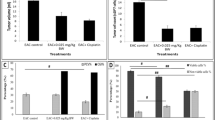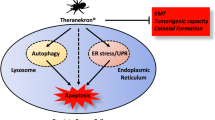Abstract
Snake venom l-Amino-acid oxidase (svLAAO) has become a critical research target in molecular biology and medical science since its widespread presence and diverse biological roles, including antitumor application. Our research confirmed that Crotalus adamanteus (C. adamanteus) venom LAAO exhibited potential anti-ovarian cancer activity both in vivo and in vitro. C. adamanteus venom LAAO significantly reduced viability of ovarian cancer cells and caused morphological changes that preceded cell death. The results of molecular biology experiments showed that C. adamanteus venom LAAO caused expression changes of genes related to apoptotic pathways either intrinsically or extrinsically in ovarian cancer cells. Animal experiments and histological analysis also proved that C. adamanteus venom LAAO could effectively inhibit the tissue damage caused by ovarian cancer, and animals treated with C. adamanteus venom LAAO showed higher survival time. Catalase blocked the major apoptosis induction of C. adamanteus venom LAAO on ovarian cancer cells, suggesting that the cytotoxicity of C. adamanteus venom LAAO on ovarian cancer cells was mainly mediated by H2O2. These results infer that C. adamanteus venom LAAO will have some advantages in new drug research and antitumor drug development in future.




Similar content being viewed by others
References
Nezhat FR, Apostol R, Nezhat C, et al. New insights in the pathophysiology of ovarian cancer and implications for screening and prevention. Am J Obstet Gynecol. 2015;213:262–7.
Kim A, Ueda Y, Naka T, et al. Therapeutic strategies in epithelial ovarian cancer. J Exp Clin Cancer Res. 2012;31:14.
Pakish JB, Jazaeri AA. Immunotherapy in gynecologic cancers: are we there yet? Curr Treat Options Oncol. 2017;18:59.
Alves RM, Antonucci GA, Paiva HH, et al. Evidence of caspase-mediated apoptosis induced by l-amino acid oxidase isolated from Bothrops atrox snake venom. Comp Biochem Physiol A. 2008;151:542–50.
Naumann GB, Silva LF, Silva L, et al. Cytotoxicity and inhibition of platelet aggregation caused by an l-amino acid oxidase from Bothrops leucurus venom. Biochim Biophys Acta. 2011;1810:683–94.
Sun LK, Yoshii Y, Hyodo A, et al. Apoptotic effect in the glioma cells induced by a specific protein extracted from Okinawa habu (Trimeresurus flavoviridis) venom in relation to oxidative stress. Toxicol Vitro. 2003;17:169–77.
Tan KK, Bay HB, Gopalakrishnakone, et al. l-amino acid oxidase from snake venom and its anticancer potential. Toxicon. 2018;144:7–13.
Hajra KM, Liu JR. Apoptosome dysfunction in human cancer. Apoptosis. 2004;9:691–704.
Schmitz I, Kirchhoff S, Krammer PH. Regulation of death receptor-mediated apoptosis pathways. Int J Biochem Cell Biol. 2000;32:1123–36.
Cory S, Adams JM. The Bcl2 family: regulators of the cellular life-or-death switch. Nat Rev Cancer. 2002;2:647–56.
Walczak H, Krammer PH. The CD95 (APO-1/Fas) and the trail (APO-2L) apoptosis systems. Exp Cell Res. 2000;256:58–66.
Loeffler M, Kroemer G. The mitochondrion in cell death control: certainties and incognita. Exp Cell Res. 2000;256:19–26.
Chaudhry P, Srinivasan R, Patel FD. Differential expression of fas family members and bcl-2 family members in benign versus malignant epithelial ovarian cancer (EOC) in North Indian population. Mol Cell Biochem. 2012;368:119–26.
Duiker EW, Zee AGJVD, Graeff PD, et al. The extrinsic apoptosis pathway and its prognostic impact in ovarian cancer. Gynecol Oncol. 2010;116:549–55.
Chang JS, Hsu YL, Kuo PL, et al. Upregulation of fas/fas ligand-mediated apoptosis by gossypol in an immortalized human alveolar lung cancer cell line. Clin Exp Pharmacol Physiol. 2004;31:716–22.
Rabinowich H, Reichert TE, Kashii Y, et al. Lymphocyte apoptosis induced by fas ligand-expressing ovarian carcinoma cells. implications for altered expression of t cell receptor in tumor-associated lymphocytes. J Clin Invest. 1998;101:2579–88.
Cacan E. Histone deacetylase-1-mediated suppression of fas in chemoresistant ovarian cancer cells. Anticancer Res. 2016;36:2819.
Möröy T, Zörnig M. Regulators of life and death: the bcl-2 gene family. Cell Physiol Biochem. 2008;6:312–36.
Roucou X, Rostovtseva T, Montessuit S, et al. Bid induces cytochrome c-impermeable bax channels in liposomes. Biochem J. 2002;363:547–52.
Goncharenko-Khaider N, Lane D, Matte I, et al. The inhibition of bid expression by akt leads to resistance to trail-induced apoptosis in ovarian cancer cells. Oncogene. 2010;29:5523–36.
Esposti MD. The roles of Bid. Apoptosis. 2002;7:433–40.
Green DR, Reed JC. Mitochondria and apoptosis. Science. 1998;281:1309–12.
Roby KF, Taylor CC, Sweetwood JP, et al. Development of a syngeneic mouse model for events related to ovarian cancer. Carcinogenesis. 2000;4:585–91.
Burin SM, Ayres LR, Neves RP, et al. l-amino acid oxidase isolated from bothrops pirajai induces apoptosis in bcr-abl-positive cells and potentiates imatinib mesylate effect. Basic Clin Pharmacol Toxicol. 2013;113:103–12.
Santos MMDV, Sant’Ana CD, Giglio JR, et al. Antitumoural effect of an l-amino acid oxidase isolated from bothrops jararaca snake venom. Basic Clin Pharmacol Toxicol. 2008;102:533–42.
Torii S, Yamane K, Mashima T, et al. Molecular cloning and functional analysis of apoxin I, a snake venom-derived apoptosis-inducing factor with l-amino acid oxidase activity. Biochemistry. 2000;39:3197–205.
Kanzawa N, Shintani S, Ohta K, et al. Achacin induces cell death in HeLa cells through two different mechanisms. Arch Biochem Biophys. 2004;422:103–9.
Vermeulen K, Bockstaele D, Berneman ZN. The cell cycle: a review of regulation, deregulation and therapeutic targets in cancer. Cell Prolif. 2010;36:131–49.
Acknowledgements
This research was supported by the Chongqing Normal University Fund project (Grant Nos. 17XLB013, 19XLB006).
Author information
Authors and Affiliations
Corresponding author
Ethics declarations
Conflict of interest
We declare that we have no commercial or associative interest that represents a conflict of interest in connection with the work submitted.
Consent for publication
All authors agree with publication.
Additional information
Publisher's Note
Springer Nature remains neutral with regard to jurisdictional claims in published maps and institutional affiliations.
Supplementary Information
Below is the link to the electronic supplementary material.
Rights and permissions
About this article
Cite this article
Xiong, Y., He, Q., Yu, X. et al. The anti-ovarian carcinoma activity of l-amino acid oxidase from Crotalus adamanteus venom in vivo and in vitro. Med Oncol 39, 112 (2022). https://doi.org/10.1007/s12032-022-01729-5
Received:
Accepted:
Published:
DOI: https://doi.org/10.1007/s12032-022-01729-5




